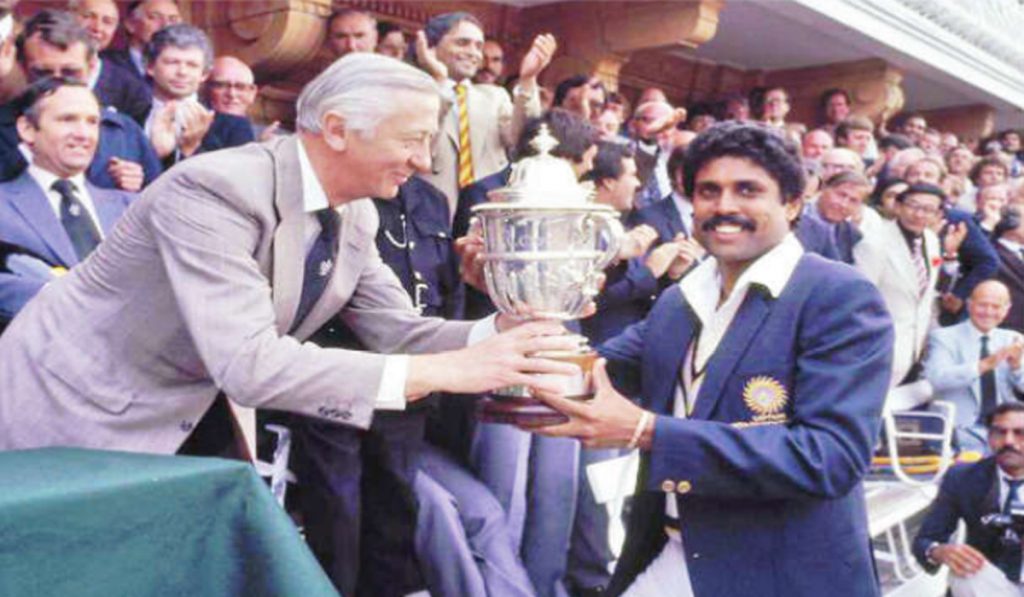Whenever I focused more on playing cricket than studying during my school days, my father would drag me off the field, scolding me with these very words. As a child, I couldn’t comprehend what it meant. Only later did I realize that this phrase referred to India’s historic victory in the 1983 Cricket World Cup under the leadership of Kapil Dev — a monumental moment that popularized the sport across the country.
The influence of Kapil Dev and his champion team lingered well into the 1990s, inspiring millions of cricket lovers like us to take up the game. At the time, hockey was still India’s national sport and held a stronger position in the public’s eye. But the 1983 World Cup win changed that, taking cricket from stadiums into every alley and street of India. I was just four years old when India won the World Cup. As I grew up, I witnessed the parallel rise of cricket’s popularity in Indian streets. Lacking proper resources, we often used four or five bricks as stumps and washing paddles in place of bats.
Though our love for cricket was strong, my disciplined father was completely against compromising studies, and as a result, we often found ourselves being punished — with both our makeshift bats and our backs bearing the consequences. Yet, the 1983 World Cup victory marked a turning point in Indian cricket history, one that the entire world now recognizes. Although cricket arrived in India with the British, it gained popularity rather early.
Alongside games like polo and hunting, cricket also found favor among Indian princely states and their rulers. These kings and princes played a pivotal role in nurturing and spreading the game. They often used cricket to form bonds with the British and establish themselves as prominent patrons of the sport. Prominent among them were Maharaja Bhupinder Singh of Patiala, Maharaja Ranjitsinh (after whom the Ranji Trophy is named), Maharajkumar of Vizianagaram, and many others. Thanks to their involvement, cricket gradually took root in India.
Over time, India produced s e v e r a l r e n o w n e d cricketers like Vijay Merchant, Vinoo Mankad, V i j ay H a z a r e, C K Nayudu, Lala Amarnath, Ajit Wadekar, Bishan Singh Bedi, Erapalli Prasanna, and Bhagwat Chandrasekhar. However, none of them were able to bring cricket into every Indian household the way the 1983 victory did. In fact, when Kapil Dev led the Indian team to the 1983 World Cup, most people in the country weren’t even aware of it. India was considered an underdog — and rightly so. In the previous two World Cups (1975 and 1979), India had won only one match, that too against East Africa. Moreover, there were rumors of discontent within the team itself.
Senior players were reportedly unhappy with being led by a younger, relatively inexperienced Kapil Dev. Despite these challenges, India played eight matches in the tournament, won six, and lifted the Cup — shocking the cricketing world. The journey was not easy. After early victories against the West Indies and Zimbabwe, India was defeated heavily by Australia and the West Indies in the later stages. A must-win game against Z i m b a b w e b e c a m e crucial. But India’s start was disastrous, losing five wickets for just 17 runs. It was then that captain Kapil Dev walked onto the field and changed the course of history. Scoring an unbeaten 175 runs off 138 balls — the highest individual score in One Day Internationals at the time — he not only rescued India from near-certain defeat but also propelled the team into the semifinals.
Unfortunately, due to a strike by the BBC, this iconic innings was not recorded, depriving future generations of witnessing it. Nonetheless, Kapil’s magical knock helped India defeat Zimbabwe by 38 runs. India then faced Australia again and, reversing their earlier defeat, knocked them out with a stellar performance. In the semifinal, India clashed with hosts England and stunned everyone with a well-coordinated team effort that eliminated the home side. The final was a clash against the mighty West Indies — two-time world champions and the strongest side in the tournament. Known for their formidable fast bowlers, West Indies were expected to win easily. But once again, India defied expectations. Though every Indian player contributed significantly to the tournament — including Mohinder Amarnath, Kirti Azad, Roger Binny, Sunil Gavaskar, Syed Kirmani, Madan Lal, Sandeep Patil, Balwinder Sandhu, Yashpal Sharma, Ravi Shastri, Krishnamachari Srikkanth, and Dilip Vengsarkar — it was Kapil Dev’s all-round brilliance and leadership that stood out.
One unforgettable moment was in the final when West Indies star batsman Vivian Richards lofted the ball, and Kapil Dev ran backwards to take an incredible catch. That moment signaled the collapse of the West Indies batting lineup, and India emerged as the world champion. This victory 42 years ago not only immortalized Kapil Dev but also revolutionized the status of cricket in India.
A game once frowned upon by parents was now producing stars from ordinary households — young boys bringing glory to their families and the nation. The 1983 World Cup victory was indeed a watershed moment, one that laid the foundation for cricket’s transformation into a religion in India. It brought cricket and its players into the hearts of millions.
In today’s era, where youth are increasingly engrossed in electronic gadgets and neglecting their health, it is important to remind them of such transformative moments in our sporting history. They serve as motivation and encouragement for achieving greater heights in the field of sports.
Authored by Manvinder Singh
Joint Director, Department of Information and Public Relations, Punjab
